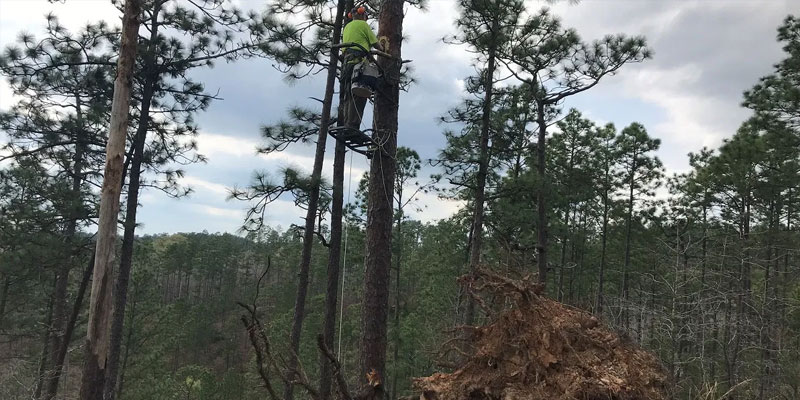The storms that tore through Alabama last month took a toll on a rare longleaf pine forest near Lake Mitchell, but Alabama Power biologists have moved in to make repairs ahead of the nesting season for a protected woodpecker.
Chad Fitch, a biologist with Alabama Power, said the storm took down numerous trees in the 1,600-acre, old-growth longleaf pine forest that the company has helped nurture over more than 30 years. Longleaf pine forests are critical habitat for a wide variety of animals and plants, including the federally protected red-cockaded woodpecker.
Fitch said the company’s biology team surveyed the damage and discovered that the storm had toppled nine longleaf pines that contained nesting cavities used by the woodpeckers to breed. With nesting season just a few weeks away, the company’s stewardship team this week began replacing the destroyed cavities with new, artificial ones that are being inserted in standing pines.
“We want to get ahead of the nesting season and do what we can to keep our ongoing breeding efforts on track, despite the recent damage,” Fitch said.
Over the past 25 years, experts have refined a process of inserting artificial nesting cavities – essentially small birdhouses – into mature longleaf pines, which red-cockaded woodpeckers will inhabit, just like they would natural cavities. Because it can take years for woodpeckers to create new cavities on their own, the artificial cavities have been critical in helping increase the population of the rare birds.
Artificial nesting cavities have helped to expand the breeding population of red-cockaded woodpeckers at the Lake Mitchell site and at many others across the South. Last year, for example, there were 11 breeding pairs of woodpeckers thriving in the Lake Mitchell forest, up from eight breeding pairs identified in the forest in the 1990s.
Prior to western colonization, an estimated 1 million-plus red-cockaded woodpeckers lived in the United States. But over the past three centuries, that number has shrunk dramatically because of habitat destruction. In 1970, the woodpecker was placed on the federal endangered species list after its estimated population dropped below 10,000.
The clearing of longleaf pine forests, the preferred habitat for red-cockaded woodpeckers, is directly tied to the historic decline of the bird. Once believed to cover more than 90 million acres across the Southeast, longleaf pines now thrive on about 3% of the trees’ historic range, although in recent years multiple public agencies, nonprofits and private landowners have worked together to expand longleaf forests across the South. Alabama Power and its parent company, Southern Company, are among those actively supporting efforts to restore longleaf pine habitat and expand the red-cockaded woodpecker population.
Last fall, the U.S. Fish and Wildlife Service proposed “downlisting” the red-cockaded woodpecker from endangered status to threatened, because of ongoing, successful efforts to protect and expand the bird’s population. The agency said the downlisting is warranted because the species is no longer in danger of extinction, although a listing of threatened would still provide the bird government protections.
Fitch said real progress has been made across the South to add to the woodpecker population, thanks to a number of initiatives, including habitat protection and expansion, and “translocation” during which experts carefully capture and move birds to new sites to expand the number of breeding groups in the wild.
He said the repair and replacement work taking place in the longleaf forest at Lake Mitchell will hopefully ensure the population there continues to grow.
(Courtesy of Alabama NewsCenter)
Don’t miss out! Subscribe today to have Alabama’s leading headlines delivered to your inbox.
